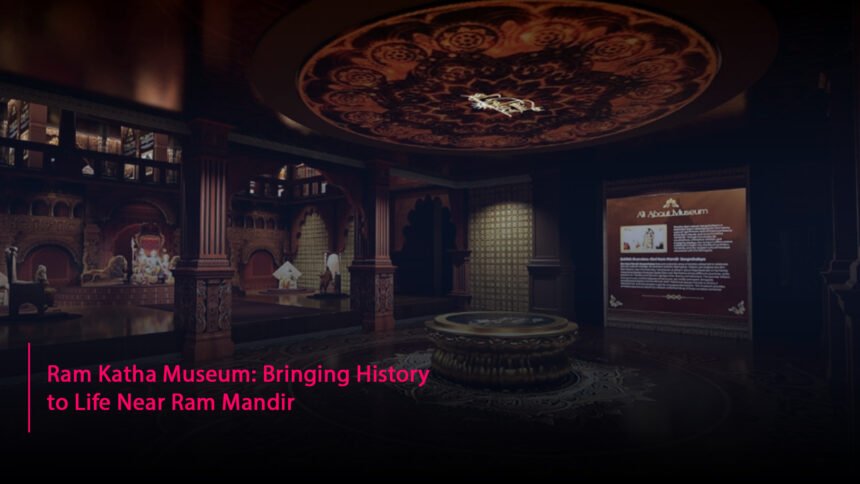In the days leading up to the first anniversary of the Ram Mandir’s inauguration, a new and exciting project is taking shape in Ayodhya — the Ram Katha Museum. Set to be housed in the former Sangrahalaya (archives) building, just 4 kilometers from the temple, the museum promises to be a landmark addition to the city.
The museum will offer a fascinating experience, featuring a hologram that brings Lord Ram to life, an immersive journey through the events of the Ramayana, and a special section dedicated to the 200-year-long Ram Temple movement. Additionally, it will display archaeological findings that provide solid evidence of the temple’s ancient origins.
Spanning over 40,000 square feet, the Ram Katha Museum is set to become the second-largest attraction in Ayodhya once it is completed, adding to the rich cultural heritage of the city.
The Ram Katha Museum project is currently in the concept and design phase. Once the plans are finalized, a detailed project report (DPR), including architectural drawings, will be prepared. The building is owned by the state government, but the temple trust will cover the project’s costs. The museum is expected to be completed within the next two years.
Saurav Bhaik, CEO of Tagbin, the company responsible for implementing the project, explained, “Our main focus will be on creating the right design, content, and technology to ensure the museum appeals to visitors of all ages.”

During excavations at the temple site, led by the Archaeological Survey of India (ASI) under the guidance of the Supreme Court, many artifacts connected to the ancient temple were uncovered. Over 100 artifacts were discovered, including pieces of statues, pillars, and wall panels. These discoveries offer strong evidence that an ancient temple existed at this location. Some of these items will be displayed in the museum,” said Bhaik.
In addition to displaying artifacts from archaeological excavations that offer solid proof of the temple’s ancient history, the museum will feature archival records that trace the evolution of the Ram Temple movement. “These elements will not only emphasize the historical and cultural importance of the Ram Temple but also reflect the dedication and passion of those who contributed to this remarkable legacy,” said Bhaik.
The museum will cover three floors – lower ground, ground, and first – and will be divided into 26 sections, each providing a different perspective on the life and legacy of Lord Ram. In addition, a projection mapping display will enhance the museum’s facade, adding a dynamic visual element to the experience.
The museum will begin with an introductory section offering an overview of its exhibits, followed by a series of unique displays. The ‘Ram Darbar’ section will feature a holographic representation of Lord Ram’s court, while ‘Ikshwaku Vanshavali’ will present the family tree of his dynasty. ‘Sabke Ram’ will share various stories from his life, and a section dedicated to Ram Katha will explore how the tale is told in different countries. Visitors will also experience ‘Ram Van Path’, a ramp decorated with images of places Lord Ram visited during his exile, and ‘Maharshi Valmiki’s Holobox’, which will showcase the Ramayana and Yog Vasistha through interactive 3D displays.
Looking at more recent history, there will be an entire section focused on the architecture of the new Ram Temple, and another titled ‘Sri Ram Janmabhoomi Sangharsh Yatra’, which chronicles the journey of the Ram Janmabhoomi movement. A holographic show will bring Ayodhya’s history to life, and ‘Odyssey of Hanuman’, created by IIT-Madras, will highlight Lord Hanuman’s journey. There will also be a live view of Ram Lalla from the Garbh Griha of Shri Ram Mandir. The museum will also feature temporary exhibitions from time to time.
The project aims to take visitors on a journey through time using immersive technologies like augmented reality (AR), virtual reality (VR), and artificial intelligence (AI). A major highlight will be a lifelike statue of Lord Ram that not only shows intricate hand movements but also speaks, providing an engaging and interactive experience. Our aim is to offer an immersive experience of the Ramayana, making visitors feel as if they are experiencing the events firsthand,” said Bhaik.
Regarding the sources for the temple movement, Bhaik explained that the entire movement is thoroughly documented, with significant involvement from the Nirmohi Akhara, the Vishwa Hindu Parishad, and the Sunni Waqf Board. “The movement spans a 200-year journey, beginning in 1822, and includes important legal, cultural, and historical milestones,” he said.The story of the movement will be crafted by experts from different fields to ensure it is both historically accurate and sensitive. It will also go through a thorough review and approval process.
As for the construction of the Ram Temple, the temple construction committee stated that the work on the first and second floors, along with the shikhar (spire) and other key temples, is in its final phase, with completion expected by June this year.










